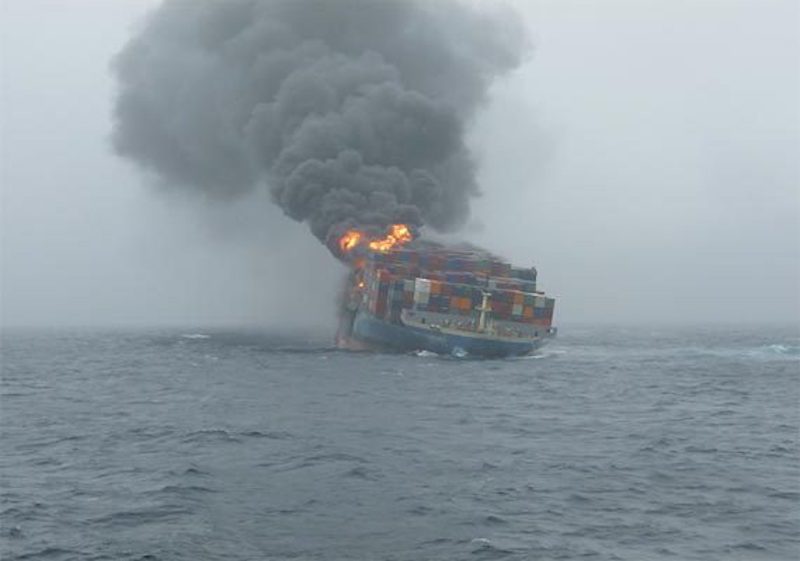The forward section of the MOL Comfort on fire in the Indian Ocean, July 2013.
The International Association of Classifications Societies (IACS) has announced the adoption of new rules to further improve the safety of Large Container Ships by enhancing consistency between pre-existing Class Society requirements.
The new rules are combined within a single new Unified Requirement, known as UR S11A, and includes three new safety measures that provide a robust, timely and complete response to the findings of the investigation by Japan’s Ministry of Land, Infrastructure, Transport and Tourism (MLIT) and subsequent papers to the IMO into the 2012 MOL Comfort disaster in the Indian Ocean. UR S11A is also further complemented by an additional Unified Requirement (UR S34) which deals with minimum loading conditions to be analyzed.
IACS welcomed the publication of the casualty investigation report into the MOL Comfort incident in March 2015 and also thanked Japan and Bahamas for bringing the results of the investigation to international shipping’s primary regulator, the International Maritime Organization.
In anticipation of these developments, IACS established at the beginning of 2014 an expert group on structural safety of container ships which carried out a post “MOL Comfort” review of available information which also took into account a number of past casualties. The work has resulted in the development of UR S11A, providing a longitudinal strength standard for Containerships that explicitly addresses the three issues requested of both individual classification societies and IACS by the authors of the MLIT investigation report.
In brief:
Bi-axial stresses which would be induced by lateral loading, i.e. external pressure on the bottom shell: IACS Members have for many years addressed these bi-axial stresses in their individual rules and procedures. The effect of the lateral loads which induce bi-axial stresses of bottom shell plates should be considered in the requirements of the hull girder ultimate strength and this will now be recognized in the new IACS Longitudinal Strength Standard for Container Ships, known as Unified Requirement S11A which will enter into force on 1 July 2016.
The whipping effect on container ships: Although this phenomenon continues to be the subject of research, the effects are becoming better understood and some individual IACS Members have developed specific rule requirements in this regard. The development of an IACS Unified Requirements for the whipping component of hull girder loading will take time, however in the interim IACS has introduced a functional requirement into the new Unified Requirement S11A which requires IACS Members to take into account whipping in accordance with their individual procedures. Entry into force is also set for 1 July 2016.
A revised wave bending magnitude and longitudinal distribution has been included in the development of the new Unified Requirement S11A, with full details to be made available on the IACS website shortly.
Additionally, UR S34 will set consistent requirements among IACS members by defining the unified minimum load cases used while performing strength assessment of container ships by Finite Element (FE) analysis. This fulfills two principal aims; first by prescribing high-level “functional requirements” on loads, the bottom line of structural strength becomes unified and, secondly, by developing a minimum set of common loading conditions for Cargo Hold Analysis in the midship region, a baseline for structural strength at cargo hold in the midship region is achieved.
New S34 is applicable to container ships only and will apply from 1 July 2016 and requires a Global (full ship) analysis for ships with length ? 290m and a Cargo hold analysis for ships with length ? 150m.
In accordance with IACS commitment to safety and transparency, the 50+ pages of new requirements are available on the IACS website along with the detailed Technical Background.
Introducing the new URs at the IMO on Thursday, IACS Chairman, Philippe Donche-Gay, commented:
“Once again IACS has demonstrated its unrivalled technical capacity by delivering important Unified Requirements in a very tight timeframe that will further enhance Large Container Ship safety. IACS is proud of its contribution to this important debate and stands ready to continue to assist the IMO in all areas where technical expertise can advance our common goal of safer and cleaner ships.”

 Join The Club
Join The Club











